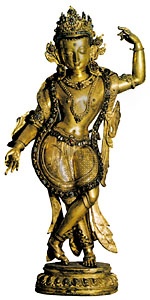Krishna
Hindu deity
Sanskrit Kṛṣṇa
 one of the most widely revered and most popular of all Indian divinities, worshipped as the eighth incarnation (avatar, or avatāra) of the Hindu god Vishnu and also as a supreme god in his own right. Krishna became the focus of numerous bhakti (devotional) cults, which over the centuries have produced a wealth of religious poetry, music, and painting. The basic sources of Krishna's mythology are the epic Mahābhārata (Mahabharata) and its 5th-century-AD appendix, the Harivaṃśa, and the Purāṇa (Purana)s, particularly Books 10 and 11 of the Bhāgavata-Purāṇa. They relate how Krishna (literally “black,” or “dark as a cloud”) was born into the Yādava clan, the son of Vasudeva and Devakī, sister of Kaṃsa, the wicked king of Mathura (in modern Uttar Pradesh). Kaṃsa, hearing a prophecy that he should be destroyed by Devakī's child, tried to slay her children; but Krishna was smuggled across the Yamuna River to Gokula (or Vraja, modern Gokul), where he was raised by the leader of the cowherds, Nanda, and his wife Yaśodā.
one of the most widely revered and most popular of all Indian divinities, worshipped as the eighth incarnation (avatar, or avatāra) of the Hindu god Vishnu and also as a supreme god in his own right. Krishna became the focus of numerous bhakti (devotional) cults, which over the centuries have produced a wealth of religious poetry, music, and painting. The basic sources of Krishna's mythology are the epic Mahābhārata (Mahabharata) and its 5th-century-AD appendix, the Harivaṃśa, and the Purāṇa (Purana)s, particularly Books 10 and 11 of the Bhāgavata-Purāṇa. They relate how Krishna (literally “black,” or “dark as a cloud”) was born into the Yādava clan, the son of Vasudeva and Devakī, sister of Kaṃsa, the wicked king of Mathura (in modern Uttar Pradesh). Kaṃsa, hearing a prophecy that he should be destroyed by Devakī's child, tried to slay her children; but Krishna was smuggled across the Yamuna River to Gokula (or Vraja, modern Gokul), where he was raised by the leader of the cowherds, Nanda, and his wife Yaśodā.The child Krishna was adored for his mischievous pranks; he also performed many miracles and slew demons. As a youth, the cowherd Krishna became renowned as a lover, the sound of his flute prompting the gopīs (wives and daughters of the cowherds) to leave their homes to dance ecstatically with him in the forests. His favourite among them was the beautiful Rādhā. At length Krishna and his brother Balarāma returned to Mathura to slay the wicked Kaṃsa. Afterward, finding the kingdom unsafe, he led the Yādavas to the western coast of Kāthiāwār and established his court at Dvāraka (modern Dwārkā, Gujarāt). He married the princess Rukmiṇī and took other wives as well.
Krishna refused to bear arms in the great war between the Kauravas and the Pāṇḍavas but offered a choice of his personal attendance to one side and the loan of his army to the other. The Pāṇḍavas chose the former, and Krishna thus served as charioteer for Arjuna. On his return to Dvāraka, a brawl broke out one day among the Yādava chiefs in which Krishna's brother and son were slain. As the god sat in the forest lamenting, a huntsman, mistaking him for a deer, shot him in his one vulnerable spot, the heel, killing him.
Krishna's personality is clearly a syncretic one, though the different elements are not easily separated. Vāsudeva-Kṛṣṇa, a Vṛṣṇi prince who was presumably also a religious leader, was elevated to the godhead by the 5th century BC; the cowherd Krishna is obviously the god of a pastoral community that turned away from the Indra-dominated Vedic religion. The Krishna who emerged from the blending of these ideologies was ultimately identified with the supreme god Viṣṇu-Nārāyaṇa and, hence, considered his avatar. His cult preserved distinctive traits, chief among them an exploration of the analogies between divine love and human love. Thus, Krishna's youthful dalliances with the gopīs are interpreted as symbolic of the loving interplay between God and the human soul.
The rich variety of legends associated with Krishna's life led to an abundance of representation in painting and sculpture. The child Krishna (Bālakṛṣṇa) is depicted crawling on his hands and knees or dancing with joy, a ball of butter held in his hands. The divine lover (the most common representation) is shown playing the flute, surrounded by adoring gopīs. In 17th- and 18th-century Rajasthani and Pahari painting, Krishna is characteristically depicted with blue-black skin, wearing a yellow dhoti (loincloth) and a crown of peacock feathers.
district, India
district, northeastern Andhra Pradesh state, southern India. Known as a delta district, Krishna has irrigation canals that connect the backwaters of the Krishna (Krishna River) and Godavari (Godavari River) rivers. Rice, millet, pulses, oilseeds, cotton, and tobacco are grown on its well-watered bottomlands. The district has many factories (sugar, cement, and soap) and commercial and scientific establishments. Vijayawada (Bezwada), Masulipatam (the district headquarters), and Nizampatam are important towns and cities. Area 3,370 square miles (8,727 square km). Pop. (2001) 4,218,416.
- vinyl compound
- vinyl fluoride
- vinylidene chloride
- Vinícius de Morais
- viol
- Viola
- viola
- Viola Allen
- Viola, Bill
- Violence Against Women Office
- Violeta Barrios de Chamorro
- Violette Verdy
- violin
- Violle, Jules
- Viollet-le-Duc, Eugène-Emmanuel
- Viotti, Giovanni Battista
- viper
- viperfish
- Viphya Mountains
- Vipsania Agrippina
- Viracocha
- viral hemorrhagic fever
- Virchow, Rudolf
- Virden
- virelai